Experimental 35 GHz Gyrotron Efficiency Enhancement with Magnetic Field Taper in Fundamental Harmonic
Abstract
:1. Introduction
2. Magnetic Field Profile
3. Experimental Setup
4. Experimental Results
5. Discussion
Author Contributions
Funding
Data Availability Statement
Conflicts of Interest
References
- Nusinovich, G.S.; Thumm, M.K.A.; Petelin, M.I. The Gyrotron at 50: Historical Overview. J. Infrared Millim. Terahertz Waves 2014, 35, 325–381. [Google Scholar] [CrossRef]
- Idehara, T.; Sabchevski, S.P.; Glyavin, M.; Mitsudo, S. The Gyrotrons as Promising Radiation Sources for THz Sensing and Imaging. Appl. Sci. 2020, 10, 980. [Google Scholar] [CrossRef]
- Flyagin, V.; Gaponov, A.; Petelin, I.; Yulpatov, V. The Gyrotron. IEEE Trans. Microw. Theory Tech. 1977, 25, 514–521. [Google Scholar] [CrossRef]
- Chu, K.R.; Read, M.; Ganguly, A. Methods of Efficiency Enhancement and Scaling for the Gyrotron Oscillator. IEEE Trans. Microw. Theory Tech. 1980, 28, 318–325. [Google Scholar] [CrossRef]
- Lin, A.T. Mechanisms of efficiency enhancement in gyrotron backward-wave oscillators with tapered magnetic fields. Phys. Rev. A 1992, 46, R4516–R4519. [Google Scholar] [CrossRef] [PubMed]
- Read, M.; Chu, K.R.; Dudas, A. Experimental Examination of the Enhancement of Gyrotron Efficiencies by Use of Profiled Magnetic Fields. IEEE Trans. Microw. Theory Tech. 1982, 30, 42–46. [Google Scholar] [CrossRef]
- Gantenbein, G.; Borie, E. Gyrotron with a tapered external magnetic field. Int. J. Infrared Millim. Waves 1990, 11, 837–850. [Google Scholar] [CrossRef]
- Jory, H.; Bier, R.; Evans, S.; Felch, K.; Fox, L.; Huey, H.; Shively, J.; Spang, S. First 200 kW CW operation of a 60 GHz gyrotron. In Proceedings of the 1983 International Electron Devices Meeting, Washington, DC, USA, 16–24 August 1983; pp. 267–270. [Google Scholar] [CrossRef]
- Manuilov, V.N.; Polushkina, S.A. Behavior of helical electron beams in gyrotrons with high pitch factors. Radiophys. Quantum Electron. 2009, 52, 714–721. [Google Scholar] [CrossRef]
- Manuilov, V.N. Numerical simulation of low-frequency oscillations of the space charge and potential in the electron-optical system of a gyrotron. Radiophys. Quantum Electron. 2006, 49, 786–792. [Google Scholar] [CrossRef]
- Lu, D.; Fu, W.; Fedotov, A.; Glyavin, M.; Proyavin, M.; Yan, Y. Ultimate transverse power of pulsed low-voltage gyrotron beam. Phys. Plasmas 2022, 29, 093107. [Google Scholar] [CrossRef]
- Song, T.; Wang, W.; Zhang, C.; Huang, J.; Wang, S.; Chen, Q.; Liu, D.; Liu, S. Effects of the Magnetic Field Taper on a Continuously Frequency-Tunable Gyrotron. IEEE Trans. Electron Devices 2020, 67, 3815–3820. [Google Scholar] [CrossRef]
- Dumbrajs, O.; Nusinovich, G.S. Efficiency of gyrotrons with a tapered magnetic field in the regime of soft self-excitation. Phys. Plasmas 2018, 25, 013121. [Google Scholar] [CrossRef]
- Wang, X.; Xue, Q.; Zhang, S.; Liu, G.; Zhao, G.; Zhao, D. Effects of Different Magnetic Field Profiles on Output Power and Efficiency of a Second-Harmonic Gyrotron. IEEE Trans. Plasma Sci. 2019, 47, 5159–5164. [Google Scholar] [CrossRef]
- Morozkin, M.V.; Glyavin, M.Y.; Denisov, G.G.; Luchinin, A.G. A High-Efficiency Second-Harmonic Gyrotron with a Depressed Collector. Int. J. Infrared Millim. Waves 2008, 29, 1004–1010. [Google Scholar] [CrossRef]
- Bykov, Y.V.; Denisov, G.G.; Eremeev, A.G.; Flat, F.A.; Glyavin, M.Y.; Gorbachev, A.M.; Kalynova, G.I.; Kholoptsev, V.V.; Kopelovich, E.A.; Luchinin, A.G.; et al. Efficiency enhancement of gyrotron based setups for materials processing. In Proceedings of the 2009 34th International Conference on Infrared, Millimeter, and Terahertz Waves, Busan, Republic of Korea, 21–25 September 2009; pp. 1–2. [Google Scholar] [CrossRef]
- Nayek, N.; Joshi, M.K.; Sonkar, R.K.; Tiwari, T.; Bhattacharjee, R. Design and Efficiency Enhancement of a Ka-Band Industrial Gyrotron. IEEE Trans. Plasma Sci. 2020, 48, 3807–3814. [Google Scholar] [CrossRef]
- Gao, Z.-C.; Du, C.-H.; Li, F.-H.; Zhang, Z.-W.; Li, S.-Q.; Qi, X.-B.; Liu, P.-K. Design of a 330-GHz Frequency-Tunable Gyrotron With a Prebunched Circuit. IEEE Trans. Electron Devices 2022, 69, 2058–2065. [Google Scholar] [CrossRef]
- Gao, Z.C.; Du, C.H.; Li, F.H.; Zhang, Z.W.; Li, S.Q.; Liu, P.K. Forward-wave enhanced radiation in the terahertz electron cyclotron maser. Chin. Phys. B 2022, 31, 128401. [Google Scholar] [CrossRef]
- Nusinovich, G. Introduction to the Physics of Gyrotrons; Johns Hopkins University Press: Baltimore, MD, USA, 2004. [Google Scholar]
- Pagonakis, I.G.; Avramidis, K.A.; Gantenbein, G.; Rzesnicki, T.; Samartsev, A.; Jelonnek, J. Magnetic field profile analysis for gyrotron experimental investigation. Phys. Plasmas 2017, 24, 033102. [Google Scholar] [CrossRef]
- Proyavin, M.D.; Morozkin, M.V.; Luchinin, A.G.; Glyavin, M.Y.; Denisov, G.G. An Experimental Study of the Influence of the Longitudinal Magnetic-Field Distribution Profile on the Output Characteristics of a Gyrotron. Instrum. Exp. Tech. 2021, 64, 97–101. [Google Scholar] [CrossRef]
- Witman, M.; Avraham, E.; Ben-Moshe, R.; Pilossof, M.; Einat, M. Long-Pulse Uncooled Copper Magnet for Gyrotron. IEEE Trans. Electron Devices 2019, 66, 4928–4931. [Google Scholar] [CrossRef]
- Witman, M.; Einat, M.; Averbukh, M. Pulsed regulated high current source for solenoid. In Proceedings of the Electricity 2017, the Annual Convention of the Society of Electrical and Electronics Engineers in Israel (SEEEI), Eilat, Israel, 8–10 November 2017. [Google Scholar]
- Gao, Z.-C.; Du, C.-H.; Li, F.-H.; Liu, P.-K. Terahertz gyrotrons with inhomogeneous magnetic fields to suppress mode competition and enhance efficiency. J. Appl. Phys. 2021, 129, 043306. [Google Scholar] [CrossRef]
- Nusinovich, G.S. Cyclotron resonance masers with inhomogeneous external magnetic fields. Phys. Fluids B Plasma Phys. 1992, 4, 1989–1997. [Google Scholar] [CrossRef]
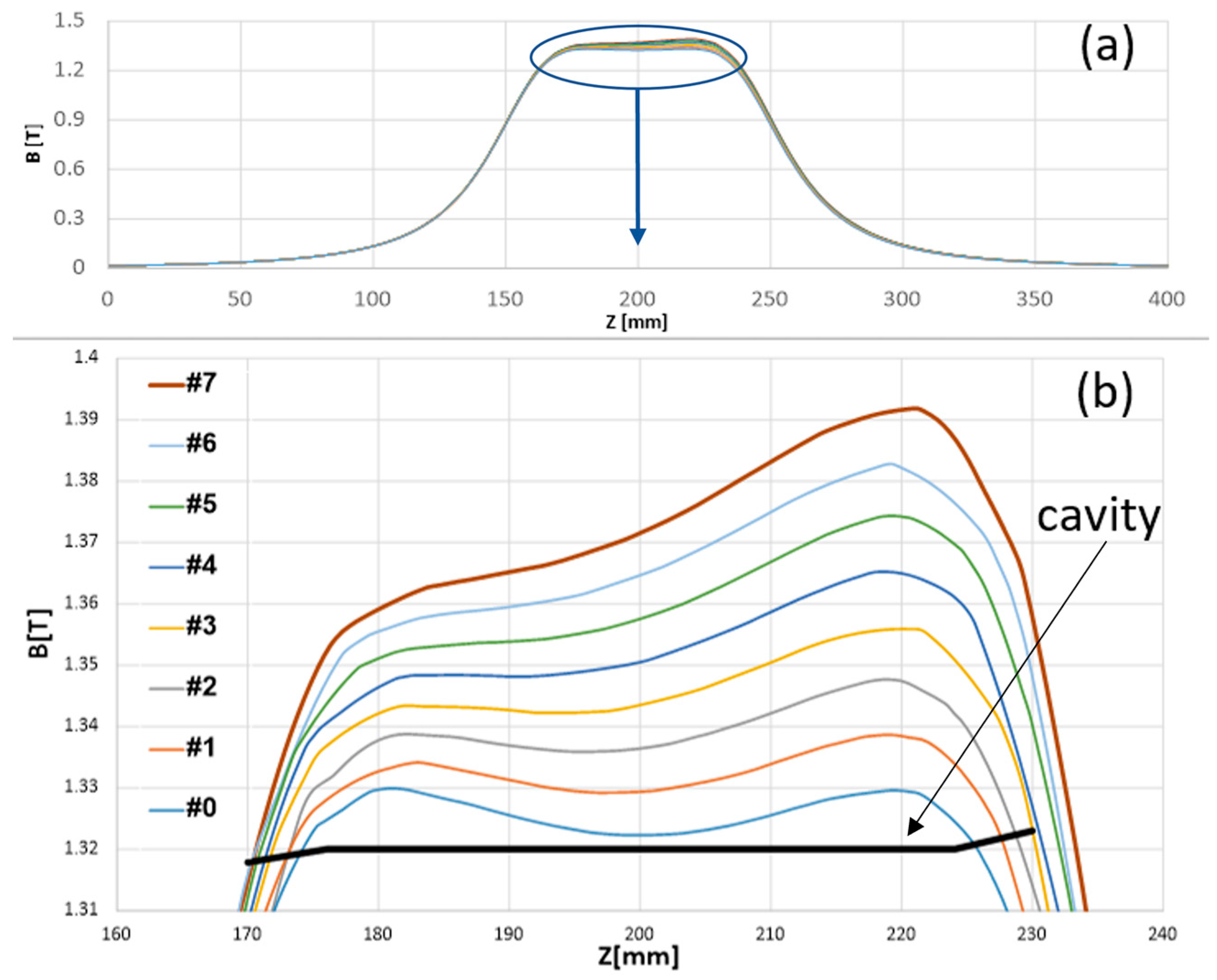

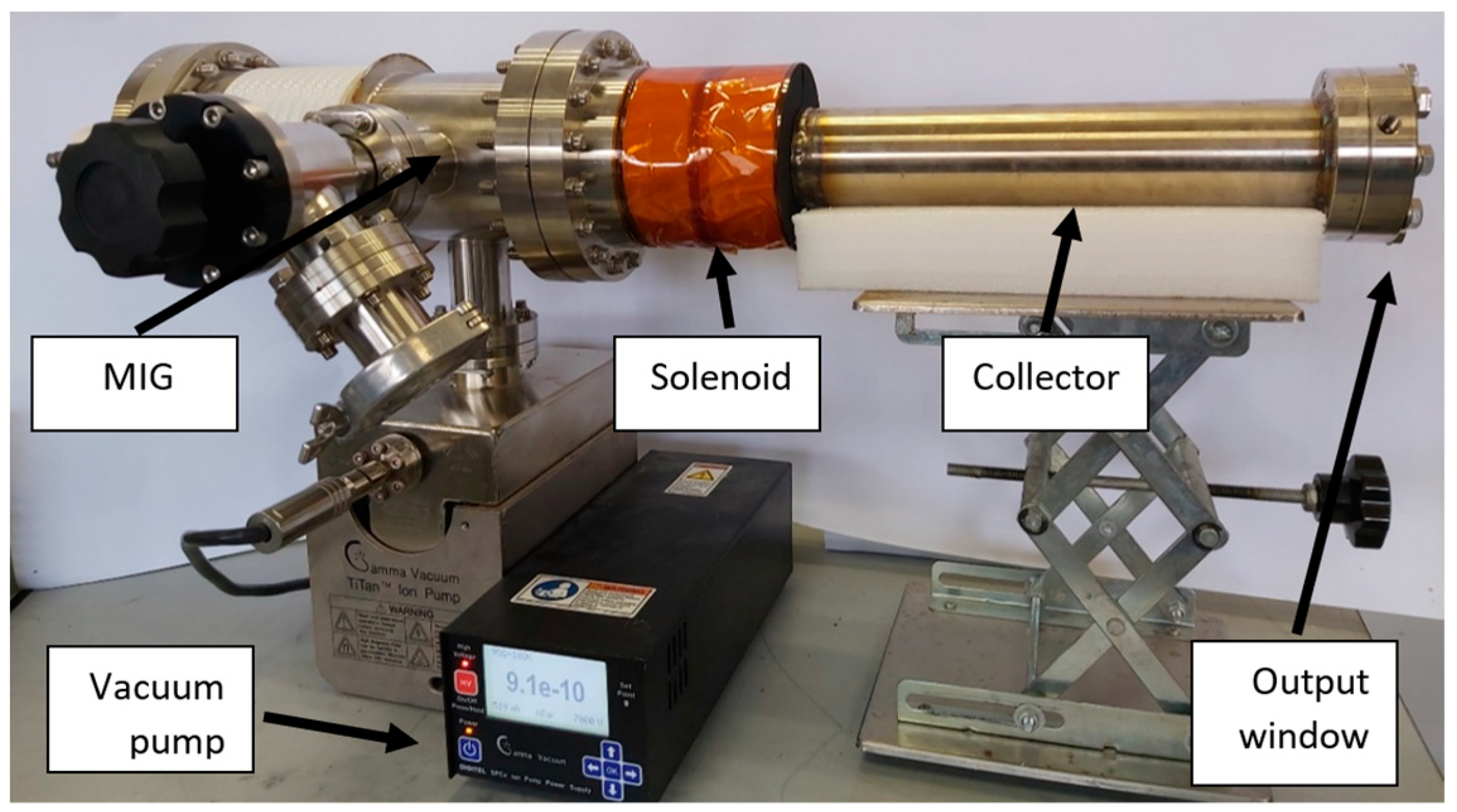
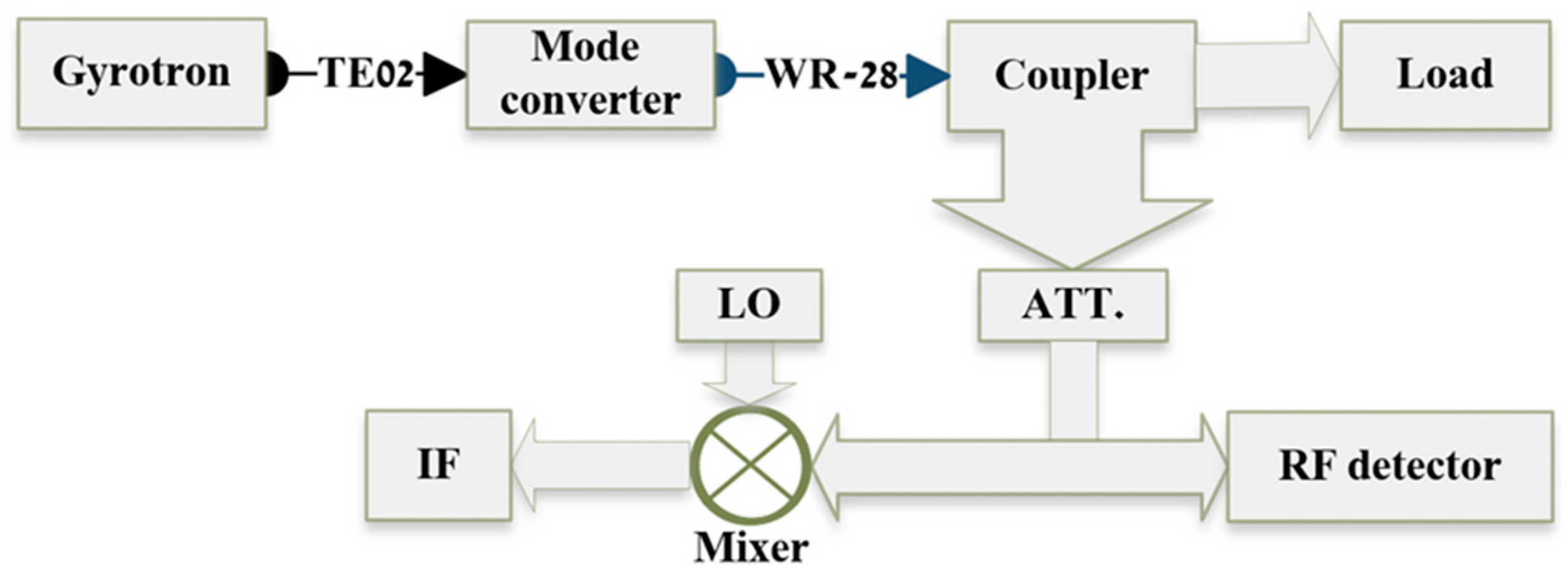



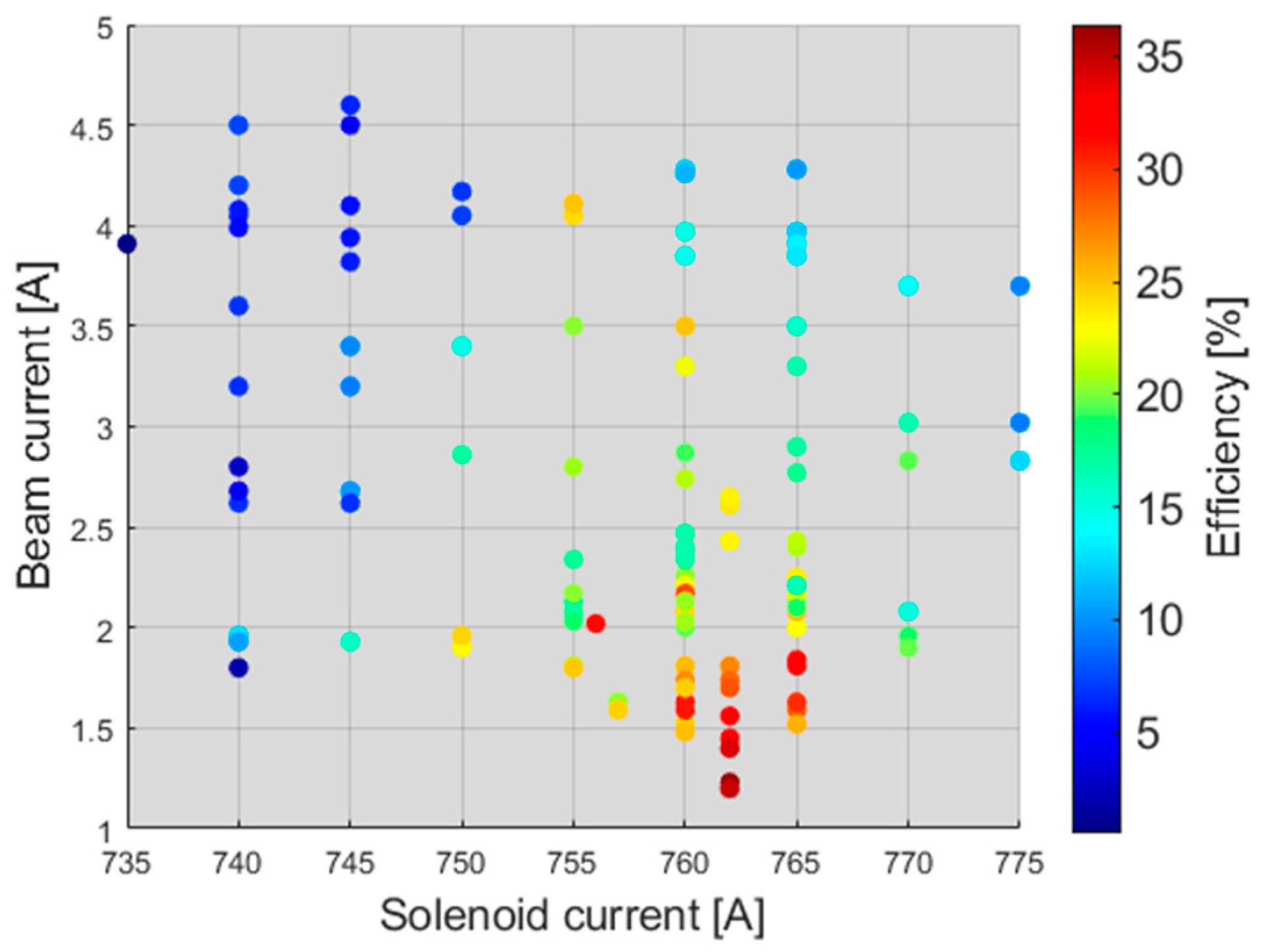
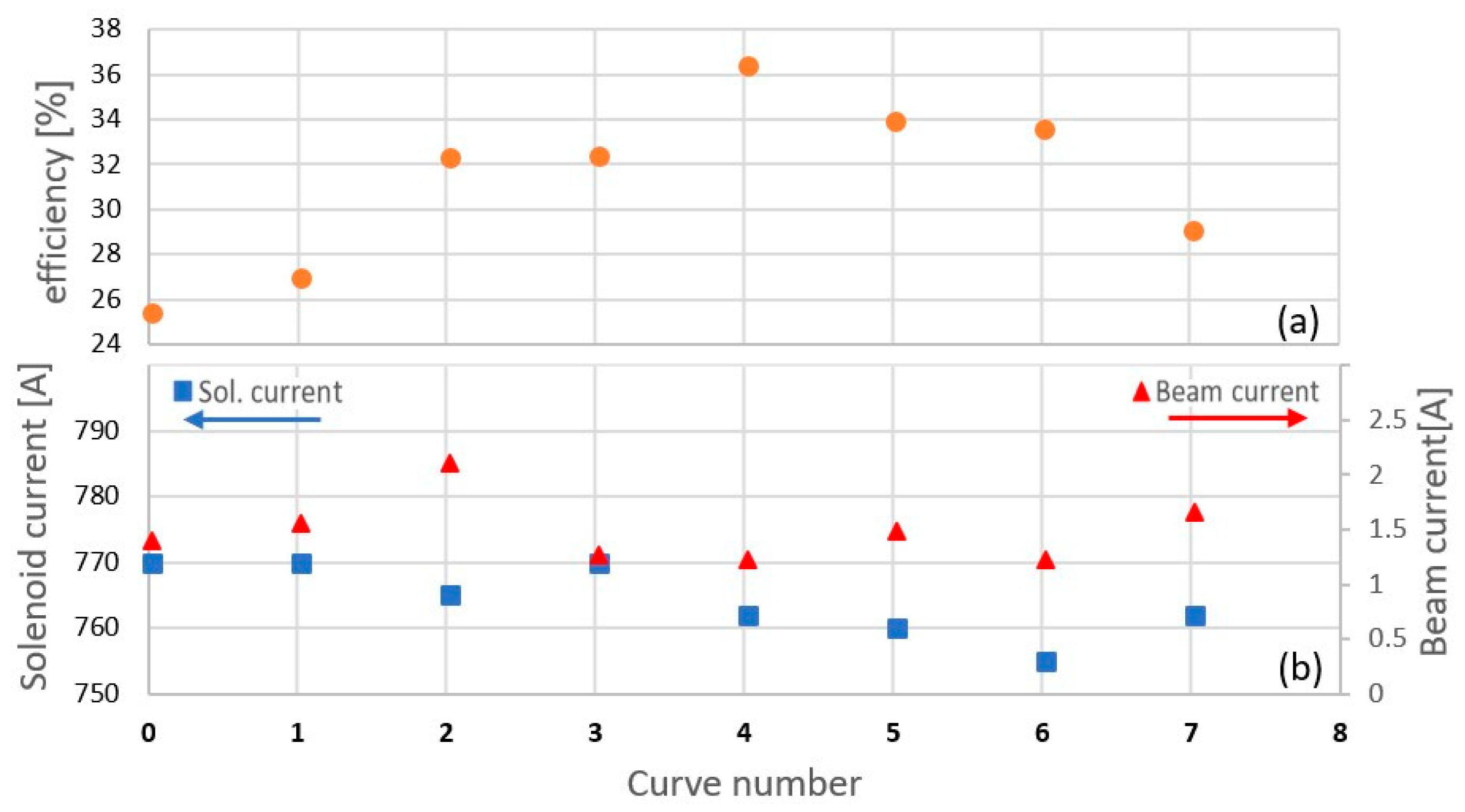
| Parameter | Value | Units |
|---|---|---|
| Voltage | 50 | kV |
| Beam current | 1–5 | A |
| Magnetic field | ~1.3 | T |
| Frequency | 35 | GHz |
| Mode | TE02 | |
| Power | 20–35 | kW |
| Pulse duration | 20–50 | μs |
| Pitch factor | 1.4 |
Disclaimer/Publisher’s Note: The statements, opinions and data contained in all publications are solely those of the individual author(s) and contributor(s) and not of MDPI and/or the editor(s). MDPI and/or the editor(s) disclaim responsibility for any injury to people or property resulting from any ideas, methods, instructions or products referred to in the content. |
© 2024 by the authors. Licensee MDPI, Basel, Switzerland. This article is an open access article distributed under the terms and conditions of the Creative Commons Attribution (CC BY) license (https://creativecommons.org/licenses/by/4.0/).
Share and Cite
Shevchenko, S.; Shay, Y.; Pilossof, M.; Einat, M. Experimental 35 GHz Gyrotron Efficiency Enhancement with Magnetic Field Taper in Fundamental Harmonic. Electronics 2024, 13, 2737. https://doi.org/10.3390/electronics13142737
Shevchenko S, Shay Y, Pilossof M, Einat M. Experimental 35 GHz Gyrotron Efficiency Enhancement with Magnetic Field Taper in Fundamental Harmonic. Electronics. 2024; 13(14):2737. https://doi.org/10.3390/electronics13142737
Chicago/Turabian StyleShevchenko, Sergey, Yarden Shay, Moritz Pilossof, and Moshe Einat. 2024. "Experimental 35 GHz Gyrotron Efficiency Enhancement with Magnetic Field Taper in Fundamental Harmonic" Electronics 13, no. 14: 2737. https://doi.org/10.3390/electronics13142737






